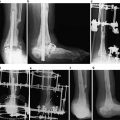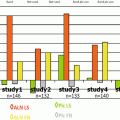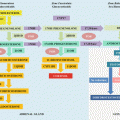Fig. 34.1
Thresholds to hormonal, symptomatic and neurological responses to hypoglycaemia in non-diabetic adults (modified from Chapter 7 Impaired Awareness of Hypoglycaemia, p. 142, Fisher and Frier 2007 Hypoglycemia in Clinical Diabetes, John Wiley and Sons)
Activation of the sympathetic neural system also contributes to the generation of peripheral symptomatic responses to hypoglycaemia. Early after diagnosis, adults characteristically experience tremor, palpitations, anxiety, sweating, hunger, paraesthesiae at glucose concentrations of around 65 mg/dl (3.5 mmol/l). These “autonomic” symptoms alert individuals and prompt them to consume carbohydrate. Additional symptoms (“neuroglycopenic”) generally develop at 50–54 mg/dl (2.8–3.0 mmol/l). These include confusion, drowsiness, odd behaviour, speech difficulties and in-coordination. Elderly patients may experience an additional group of neurological symptoms that can be confused for a cerebrovascular event [29]. Diagnosis is usually straightforward where a concomitant blood glucose is measured at the time of presentation. However, patients often treat themselves when symptomatic before checking their blood glucose.
If glucose levels fall to 35 mg/dl (2 mmol/l) or below, this usually produces profound neurological impairment which may include focal and generalised seziures. Seizures are often mistaken for idiopathic epilepsy (and rarely, vice versa) since EEG changes can be similar. In rare cases where blood glucose is less than <20 mg/dl (1.0 mmol/l) for a protracted period, irreversible neuronal damage can occur. Magnetic resonance imaging typically shows lesions in the cerebral cortex and hippocampus with sparing of hindbrain structures. Some patients may survive but remain in a persistent vegetative state [30].
Symptoms of hypoglycaemia can vary between and even within individuals. Factors which may modulate symptoms and awareness include sex, age, diurnal effects, prevalent glycaemic control, previous hypoglycaemic episodes. In adults with type 1 diabetes, symptoms are often reset to develop at lower glucose thresholds compared to non-diabetic individuals, particularly in those with tight glycaemic control or long duration diabetes. However, in those with type 2 diabetes, thresholds are often set at higher glucose levels, even on occasions in the normal range (above 70 mg/dl or 4 mmol/l) [31].
Diminished or absent warning symptoms of hypoglycaemia are major factors contributing to the risk of further severe episodes. A useful clinical “rule of thumb” is to describe patients whose warning symptoms develop at or below 55 mg/dl (3 mmol/l), around the threshold for onset of cognitive dysfunction, as having impaired awareness. Experimental studies involving non-diabetic individuals have demonstrated that counterregulatory and symptomatic responses to hypoglycaemia can be attenuated by antecedent hypoglycaemia on the previous day [32]. Some responses, such as sweating, may be depressed for as long as 8 days [33]. These observations have been confirmed in both individuals with Type 1 and Type 2 diabetes [34, 35]. Thus patients may enter a vicious cycle where hypoglycaemia begets more hypoglycaemia. Subsequent studies have demonstrated reduced hypoglycaemic awareness can be reversed (at least in part) by scrupulous avoidance of hypoglycaemia for 2–3 weeks although this sometimes occurred even without restoration of counterregulatory hormone release [36–38].
Causes of Hypoglycaemia
As described above, hypoglycaemia arises where there is an excess of insulin compared to circulating blood glucose. In the clinical situation it is frequently possible to establish a contributory cause which can be assigned one of the following categories [26]:
Excess exogenous insulin (or insulin secretagogue)—wrong dose, wrong time or formulation
Increased insulin sensitivity—e.g. nighttime, post-exercise, weight loss, early pregnancy
Decreased exogenous carbohydrate intake—e.g. missed meal, vomiting, fasting, malabsorption
Decreased endogenous glucose production—e.g. alcohol which depresses hepatic gluconeogenesis
Increased glucose utilisation—e.g. exercise
Nocturnal Hypoglycaemia
Nocturnal hypoglycaemia is common—in the Diabetes Control and Complications Trial around half of severe episodes occurred at night [39]. In a more recent study involving adults with Type 1 diabetes aiming for tight glycaemic targets, most participants experienced nocturnal hypoglycaemia with low glucose detected on 8 % of nights by continuous glucose monitoring [40]. Patients are less likely to be alerted by early/mild hypoglycaemic symptoms while asleep and children in particular may go many hours without eating overnight. Current basal insulins are limited in their ability to provide continuous physiological basal replacement. Further, counterregulatory hormonal and symptomatic responses at night are reduced due to both to the effect of supine posture and sleep. In one study, epinephrine responses were three to four times lower at night while asleep compared with when awake [41]. Studies of overnight monitoring in children with Type 1 diabetes have reported frequent, prolonged nocturnal episodes, lasting more than three hours [42], presumably due to the combined contribution of the factors identified above.
Alcohol
Alcohol has been implicated in up to a fifth of severe hypoglycaemic episodes requiring hospital admission [43]. Alcohol impairs both awareness of hypoglycaemia [44] and the ability of the person to self-treat due both to its inebriating effects and by suppressing gluconeogenesis. Alcohol also has a delayed effect on hypoglycaemia, often described as the “morning after the night before” phenomenon. Alcohol suppresses lipolysis which in turn suppresses hepatic glucose output [45], an effect which may extend into the following day. In one study of adults with type 1 diabetic, alcohol doubled the risk of hypoglycaemia in the following 24 h [46].
Exercise
Exercise has clear cardiovascular benefits in both types of diabetes and is encouraged. However, it can increase the risk of hypoglycaemia due to increase in insulin sensitivity and exercise-mediated activation of glucose utilisation in skeletal muscle. In non-diabetic individuals, exercise stimulates sympathetic activation to inhibit insulin secretion and stimulate hepatic output of glucose via glycogenolysis. In insulin-treated diabetic patients, the prevailing insulin levels are independent of and cannot be suppressed by exercise [47]. This contributes to a fall in glucose and acute hypoglycaemia during exercise but post-exercise hypoglycaemia (6–15 h later) is also a risk due to preferential repletion of muscle glycogen stores over the liver and an increase in insulin sensitivity. Exercise may also blunt subsequent counterregulatory defences to hypoglycaemic episodes [48].
Risk Factors for Hypoglycaemia
Much of the pathophysiology described is common to most individuals with diabetes, yet for some individuals, hypoglycaemia is extremely rare, while others experience multiple, disruptive and severe events. The likelihood of developing hypoglycaemia depends upon a number of contributory factors. These include those that determine the physiological capacity to counterregulate and generate awareness, pharmacology of glucose lowering agents, the ability of the individual to self-manage their diabetes and recognise and treat hypoglycaemia as well as psychological characteristics, which remain poorly understood.
Long Duration of Diabetes
One of the most important contributors to hypoglycaemic risk is duration of diabetes. In an observational UK study, adults with a duration of type 1 diabetes for over 15 years were three times more likely to experience severe hypoglycaemia compared to those with diabetes for less than 5 years [9]. This presumably reflects loss of beta cell function and counterregulatory defences with type 1 diabetes. In advanced type 2 diabetes, glucagon responses to hypoglycaemia are also progressively impaired as patients become insulin deficient [49]. The risk has been shown to be highest in those using insulin for over 5 years as rates of severe hypoglycaemia approach those of individuals with newly diagnosed type 1 diabetes [9].
Hypoglycaemia Unawareness
Nearly 20 % of patients with type 1 diabetes develop hypoglycaemia unawareness, the prevalence increasing with duration of diabetes [50]. A recent study also suggests that around 10 % of adults with type 2 diabetes also have difficulty recognising hypoglycaemia [51]. A number of scoring systems have been developed to quantify hypoglycaemia unawareness, with the Gold [52] and Clarke scores [53] being most widely adopted. Hypoglycaemia unawareness has been shown to increase the risk of severe hypoglycaemia by fivefold to sixfold in prospective surveys [52, 53]. One of the ironical consequences is that individuals with unawareness are often excluded from trials of new therapy such as insulin analogues or continuous glucose monitoring which have the potential to reduce the risk of hypoglycaemia.
Renal Failure
Renal failure is often under-recognised as a contributor to hypoglycaemia. Renal failure reduces metabolism of insulin and clearance of metabolites of drugs such as sulphonylureas. It also affects reabsorption of filtered glucose as well as gluconeogenesis (the kidneys provide as much as 30 % of glucose production due to gluconeogensis). In type 2 diabetes, it is estimated that the risk of severe hypoglycaemia is increased by twofold to threefold in those with eGFR <60 ml/min 1.73 m2 [54]. Management of diabetic patients with end stage renal failure on dialysis is particularly challenging. It usually necessitates major reductions in insulin doses and avoidance of sulphonylureas [55].
Treatment Factors
Insulin and insulin secretagogues unsurprisingly are far more likely to cause hypoglycaemia. Insulin “sensitisers” such as metformin and thiazolidiones have a minimal risk of hypoglycaemia. In the UK Prospective Diabetes Study, rate of self-reported hypoglycaemia was 0.3 % in patients on metformin monotherapy in first 6 years of diagnosis [56]. Emerging data on the incretin based therapies dipeptidyl peptidase-4 (DPP-4) inhibitors and glucagon-like peptide-1 (GLP-1) analogues indicate that risk of significant hypoglycaemia are also very low [57], unless patients are being treated concurrently with sulphonylureas or insulin.
It has been estimated that 39 % of patients on sulphonylureas alone will experience mild hypoglycaemia and severe hypoglycaemia will occur in 0.8 % each year [9]. The third generation sulphonylureas (gliclazide, glimperide) and metaglinides have a lower risk of hypoglycaemia compared to older drugs such as glyburide (glibenclamide), presumably due to shorter duration of action. The risk is increased when sulphonylureas are part of combination therapy, particularly with insulin [58].
Insulin analogues have a pharmacokinetic profile that should lower the potential for hypoglycaemia compared to human insulins. The rapid acting insulin analogues (aspart, lispro, glulisine) separate into single molecules more readily and hence are less likely to accumulate. In a meta-analysis comparing lispro with regular human insulin, the frequency of hypoglycaemia was modestly reduced (3.1 % versus 4.4 %) [59]. The peakless long acting analogues also confer a slightly lower risk for hypoglycaemia compared with isophane insulins [60]. Most if not all the benefit is generally observed for nocturnal episodes and troublesome nocturnal hypoglycaemia is a robust indication for the use of insulin analogues. Differences also exist according to the type of insulin regimen. In the 4 T study, once daily basal insulin, when initiated in type 2 diabetic patients, was associated with the lowest risk of hypoglycaemia. The risk of hypoglycaemia was higher with twice daily biphasic regimes and highest in those on prandial-basal regimes, however, fewer reached HbA1c targets in the biphasic group [61].
Psychosocial Factors
The risk of hypoglycaemia is clearly affected by the ability of the patient to recognise and self-treat. This applies particularly to the elderly and cognitively impaired. In trials of intensive glycaemic control in type 2 diabetes, patients with cognitive impairment were at higher risk of hypoglycaemia requiring assistance [62] and similar findings have been reported in community studies [63]. In a German study, one-third of type 2 diabetic patients who experienced severe hypoglycaemia lived in a nursing home or were for cared for by a home care service [64]. Patients with type 2 diabetes are more likely to require hospital care for hypoglycaemia compared with type 1 diabetic patients.
Probably one of the most important and least studied contributing factors are psychological factors which drive patients to maintain tight glycaemic targets despite the obvious risks even in those with major recurrent episodes [65]. There is some evidence that identifying these factors and addressing them specifically can reduce hypoglycaemic risk. However, much further work needs to be undertaken in understanding this important area and developing interventions to address it.
Clinical Assessment
Assessment of hypoglycaemia should be a part of every diabetes review. The clinician should establish (1) the frequency and nature of hypoglycaemic episodes and (2) the overall risk of hypoglycaemia. Figure 34.2 illustrates key points to clinical assessment. Part of this should include their daily insulin administration routine. The timing of prandial doses is important. Delayed or missed meals can result in the peak of insulin action coinciding with having little food in the system. Alternatively, patients who prefer to inject postprandially may experience episodes if the insulin peaks in the post-absorptive phase. Recurrent hypoglycaemia can also occur if patients administer boluses of short-acting insulin too close together, sometimes known as insulin “stacking”. This tends to occur where patients over-correct high glucose values by repeated insulin boluses. Injecting into areas of lipohypertrophy can lead to unpredictable absorption.
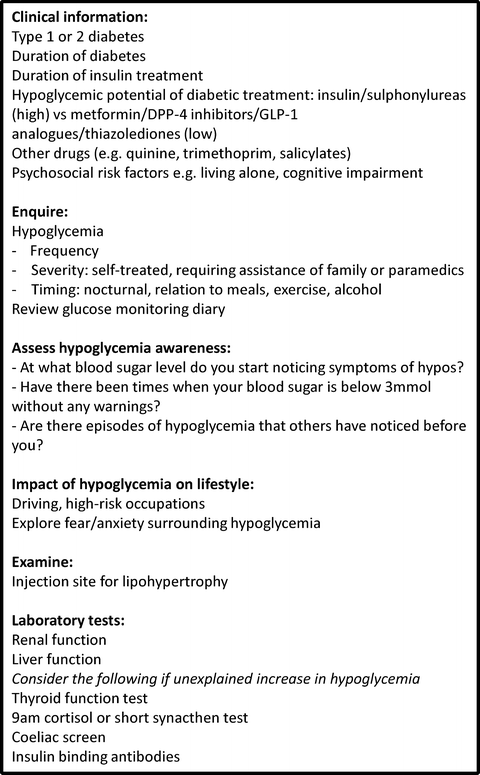

Fig. 34.2
Clinical assessment of patients with hypoglycaemia
Hypoglycaemia awareness should be assessed (Fig. 34.2) and corroboration from a relative or partner is often useful [66]. Diabetes duration, treatment regime and overall glycaemic control will determine a patient’s risk of hypoglycaemia. However, if there is a sudden increase in hypoglycaemia that appears out of proportion to the diabetes history, other medical causes should be sought such as renal failure, hepatic failure, malabsorption, hyperthyroidism or adrenal insufficiency. Certain drugs can also increase the potential for hypoglycaemia on their own or through interactions with glucose lowering agents (Fig. 34.2).
Management
Treatment of Acute Hypoglycaemia
All episodes of hypoglycaemia should be treated promptly. Mild hypoglycaemic episodes in a conscious, co-operative patient can be easily treated by rapid-acting carbohydrate (15–20 g). Figure 34.3 lists some examples of suitable treatments that are accessible and portable. Patients are often tempted to “over-treat” hypoglycaemia with excessive carbohydrate but this can lead to rebound hyperglycaemia and worsen glucose control. Rapid-acting carbohydrate should be repeated if blood glucose remains low 10–15 min later. Once blood glucose is restored to the normal range, this should be followed up with long-acting carbohydrate if a meal is not due within 1 h. In patients who are un-cooperative but able to swallow, oral glucose gels can be used. Unconscious patients should be treated with intramuscular glucagon or intravenous glucose with repeated doses of 10 % glucose solution now replacing the injection of 50 % glucose which was particularly likely to cause thrombophlebitis. In patients who are malnourished or alcohol-dependent, liver glycogen stores are depleted and glucagon may be ineffective. Intravenous glucose is preferable if venous access is available.
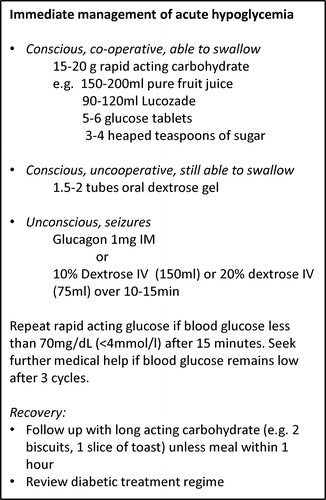

Fig. 34.3
Acute management of diabetic hypoglycaemia
Prevention of Hypoglycaemia
It is clearly important to avoid recurrent hypoglycaemic episodes and a previous history of hypoglycaemia strongly predicts future risk [67]. Education is the key to effective self-management. In type 2 diabetes, a review of treatment regimens and glycaemic targets can reduce hypoglycaemia in many cases. In type 1 diabetes patients with long disease duration and multiple risk factors, a combination of strategies, including trial of newer insulin delivery/glucose monitoring technologies may be required.
Education
Many cases of hypoglycaemia are attributed to errors in insulin usage (see above) and can be addressed by educating patients about the correct time and site of insulin administration. Specific strategies may be adopted to reduce hypoglycaemia associated with alcohol and exercise. Patients should have sufficient carbohydrate prior to alcohol and insulin may need to be reduced. The effect of exercise on glucose is affected by the duration and intensity of physical activity, and often a suitable regimen can only be determined with trial and error. Patients may need to consume extra carbohydrate prior to exercise to allow for a margin for glucose to fall. Rapid-acting or background insulin may need to be reduced depending on their exercise regime. Patients should also avoid exercising at the peak of insulin action and injecting in the exercising muscle.
Structured education programmes that integrate education on carbohydrate estimation and insulin dose adjustment, as well as hypoglycaemia advice, can make a difference to reducing hypoglycaemia. The Insulin Treatment and Training Programmes developed in Germany and its British adaptation, the Dose Adjustment for Normal Eating (DAFNE) programme, offering flexible insulin training for type 1 diabetic patients, have reported reduced rates of severe hypoglycaemia [68] and improved hypoglycaemia recognition in nearly half of those who were unaware [69]. Blood Glucose Awareness Training (BGAT) has been shown to reduce severe hypoglycaemic episodes through teaching patients to identify their individual symptoms (internal cues) and how to anticipate blood glucose extremes based on food, exercise, and insulin regimes (external cues) [70]. It may also owe its success at least in part the training in self-management which accompanies it. The psychological effects of hypoglycaemia are complex and to successfully prevent hypoglycaemia requires a multifaceted approach. Biopsychosocial interventions such as the HyPOS programme, which addresses dysfunctional beliefs about the causes and consequences of hypoglycaemia, have also been effective [71].
Individualised Glycaemic Targets
There is a consistent relationship between intensive glycaemic targets and increased risk of hypoglycaemia in clinical trials [72], although the relationship is less clear in observational studies of clinical practice [67]. The risk and benefits of intensive glycaemic control in preventing complications versus risk of hypoglycaemia needs to be weighed for individual patients and discussed with them. The American Diabetes Association and European Association for the Study of Diabetes have advocated an individualised approach to glycaemic targets [73] A HbA1c of <7 % remains the recommended goal for the majority of patients. However, in patients with a history of severe hypoglycaemia, limited life expectancy, extensive comorbidities, glucose targets which result in HbA1c concentrations of 7.5–8 % may be safer and more appropriate [73, 74].
Glucose Lowering Agents with Lower Hypoglycaemic Potential
The choice of treatment regimen should also involve a risk benefit assessment. In patients with type 2 diabetes, hypoglycaemic risk can be lowered through the use of insulin sensitisers and incretin based therapies as opposed to insulin secretagogues. Clinicians should be cautious when introducing add-on therapy as the risk is cumulative. Dose reductions may be necessary and some agents, particularly sulphonylureas may need to be stopped. Switching to analogue insulins can also reduce the risk of hypoglycaemia particularly at night. The long acting analogues (glargine, detemir) have been associated with a risk reduction of 30 % in trials in type 1 and type 2 diabetic patients [75, 76]. Analogue insulins may not be cost-effective in all patients, but are indicated in those at high risk of hypoglycaemia.
Stay updated, free articles. Join our Telegram channel

Full access? Get Clinical Tree



